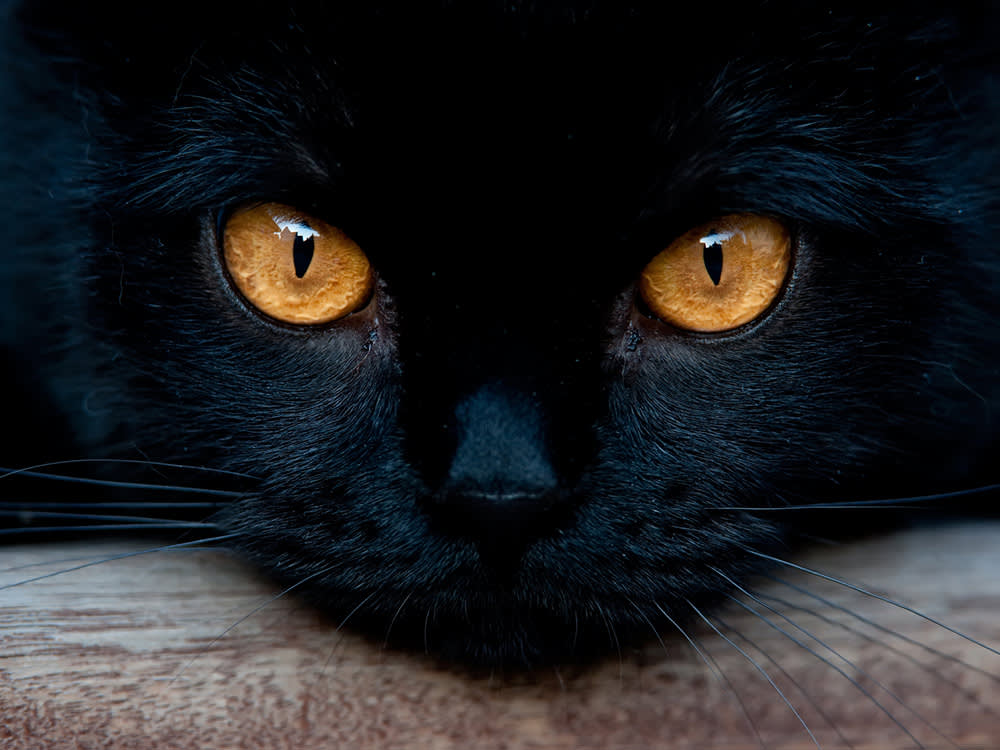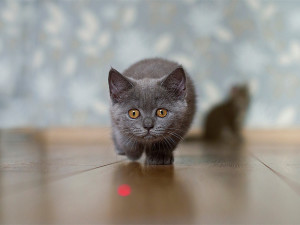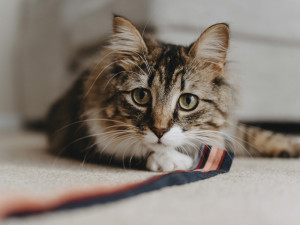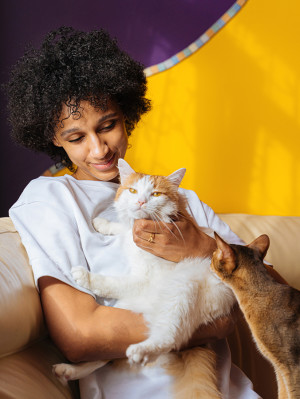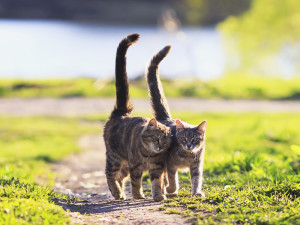Why Do Cats’ Eyes Glow in the Dark?
Those glowing orbs are actually a pretty useful result of evolution.
Do you ever walk into a room and see two glowing orbs just staring back at you? Those are your cats’ eyes, and yes, it’s slightly creepy, but it’s also just they’re wired. Cats have a special layer on the back of their eyes called the tapetum lucidum, which reflects light back through the retina. This gives cats a second chance to absorb light, which allows them to see better in low-light conditions. This is why cat eyes glow in the dark. The ability to see better in low-light conditions is beneficial for hunting and avoiding predators.
Save on the litter with color-changing tech that helps you better care for your cat.
What is the purpose of this ability?
Special adaptations of cats’ eyes allow them to monitor their territory in very low light, needing only about one-sixth of the light that humans require to see. This primal reaction is related to the evolutionary purpose of cats’ eyes to glow in the dark. Those reflective eyes actually alerted generations of humans that something was stalking them in the dark.
Cats are crepuscular animals, meaning that they are most naturally awake and seeking prey around dawn and dusk. Your house cat isn’t going to attack you (well, maybe for funsies), but their larger ancestors used their superior low-light vision to gain an advantage over their next meal when it’s dark.
How much do you spend on your pet per year?
What causes cat eyes to glow in the dark?
Cat eyes seem to glow in the dark because of a reflective layer of cells in the back of their eye. They don’t truly glow because “glowing” implies that they produce their own light. While this would be a neat feature, cats have not yet developed firefly genes.
So, why do cat eyes shine in the dark, even when it doesn’t seem like there’s enough light to create a reflection? Cats’ eyes evolved to allow a lot of light in and to use that light as effectively as possible. To accomplish this, cats had to give up some visual acuity (or sharpness). The causes of a cat’s eyes to glow in the dark are related to their eye anatomyopens in new tab.
Cats have a very large domed cornea. Compare the relative size of the clear area of a cat’s eyes to your own. Cats have a much larger portion of their eyes committed to letting light in than humans do, allowing much more light to enter the eye.
Cat pupils are also much larger than those of humans. The iris is the pigmented tissue within the eye that opens let light in through the pupil. These large pupils allow more of the light to reach the back part of the eye.
The back of the eye has many vital structures and layers that help with vision, but the most important one is the lens, which focuses as much of the light as possible on the retina. The retina is covered with rods and cones, which are special receptor cells that detect light. Cones help detect color and provide sharpness to images. Rods are stimulated at much lower light levels, but do not provide as much visual information as cones. Cats have a much higher proportion of rods than humans, which helps them see at lower light levels.
The final feature that helps a cat’s low-light vision is the tapetum lucidumopens in new tab. This reflective surface helps cats make the most of the light that enters the eye.
Tapetum lucidum
The tapetum lucidum in a cat’s eye is why they seem to shine in the dark. This layer is located in the back of the eye and reflects light that didn’t hit a rod or cone back into the eye to have a second chance to trigger a response. The tapetum of a cat is much more reflective than that of a dog, adding to their superior low-light vision.
Most commonly, an adult cat’s tapetum lucidum will reflect a green or yellow color. This color may alter a little through life, with kittens often starting out with a bluish reflection that changes to yellow or green after three to four months of age. A cat’s eyes may reflect different colors because of the differences in the tapetum in each eye. While some mild differences may be normal, any sudden changes in reflectivity or color in an adult cat should be checked out by a veterinarian.
Do all cats have a tapetum lucidum?
It is uncommon, but some cats can be born without a tapetum lucidum or with a patchy/thin tapetum. This may make their eyes reflect a red color, similar to what is seen in people with flash photography. Cats without a tapetum lucidum may have worse night vision than other cats. Don’t worry, though; the other anatomical features of their eyes mean that they likely still see better in the dark than their human parents who are stumbling to find a light switch.
What is the tapetum lucidum made of?
A cat’s tapetum lucidum is a highly organized structure. It sits between the retinal epitheliumopens in new tab (where all the light receptors are located) and the choroid, which supplies blood to the retina. A cat’s tapetum lucidum is 15 to 20 cells thick in its center but thins toward the edges. The cells of the tapetum are filled with tiny rods of riboflavin (vitamin B2), which is reflective. These rodlets are arranged in a very organized manneropens in new tab in a hexagonal lattice pattern and grouped in bundles. These reflective bundles bounce light back through the retinal epithelium, giving it a second chance to activate the rods and cones found there.
Are there other factors that contribute to cat night vision?
A cat’s eyes are made to provide superior night vision at the cost of visual acuity. The factors that improve a cat’s night vision include:
Large corneas
Wide pupils
Increased proportion of rods vs. cones
Highly reflective tapetum lucidum
These changes make cats great at detecting movement in low-light environments, but they may not be able to distinguish what they are seeing as well as a human. It is estimated that cats have 20/150 vision. This means that a cat must be over seven times closer to an object to see its details as well as a human with 20/20 vision would. This makes cats great hunters, but it does leave them with some questionable reading skills.
FAQs (People also ask):
Are there any health concerns associated with cat eye glow?
While kittens are expected to have a gradual change in the color that their eyes reflect, a sudden change in a cat’s eye glow could indicate a problem with the retina or within the eye. Get any changes checked out by your vet as soon as possible.
Can cat eye glow be captured in photos?
Cat eye glow is often captured in photos, especially those taken with flash. Even photos of cats taken in low light without a flash may show the shiny reflection off their tapetum lucidum because their eyes are so good at taking in light.
Why is only one of my cat’s eyes glowing?
While some cats may have differences in the development of the reflective surfaces between their two eyes, a big difference in the reflection could indicate a problem with the retina (like separation or bleeding) or inflammation within the eye.
